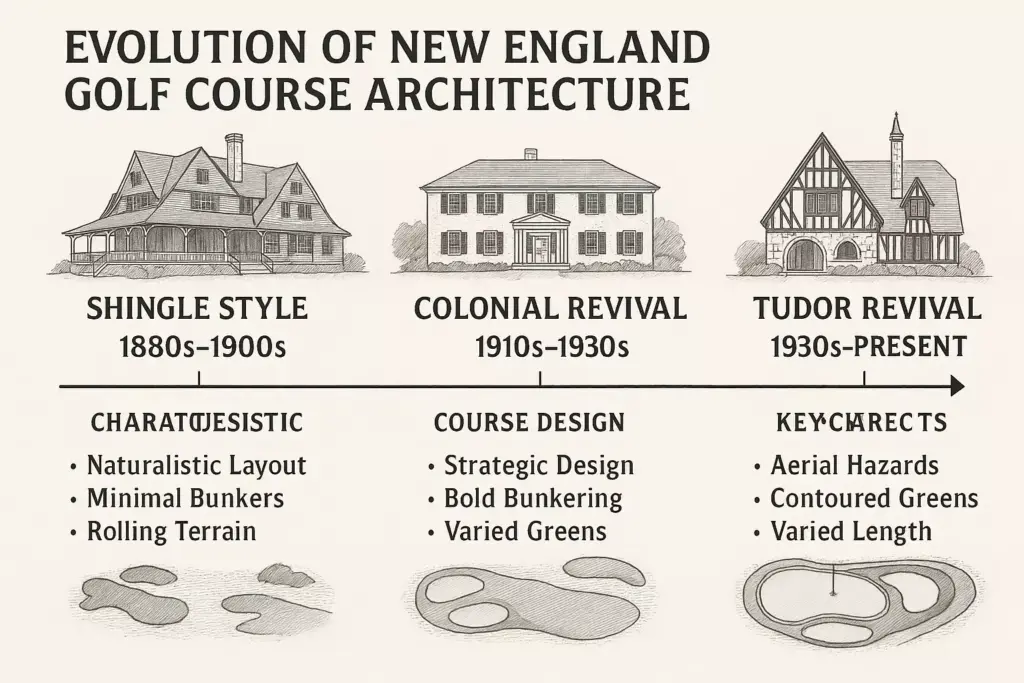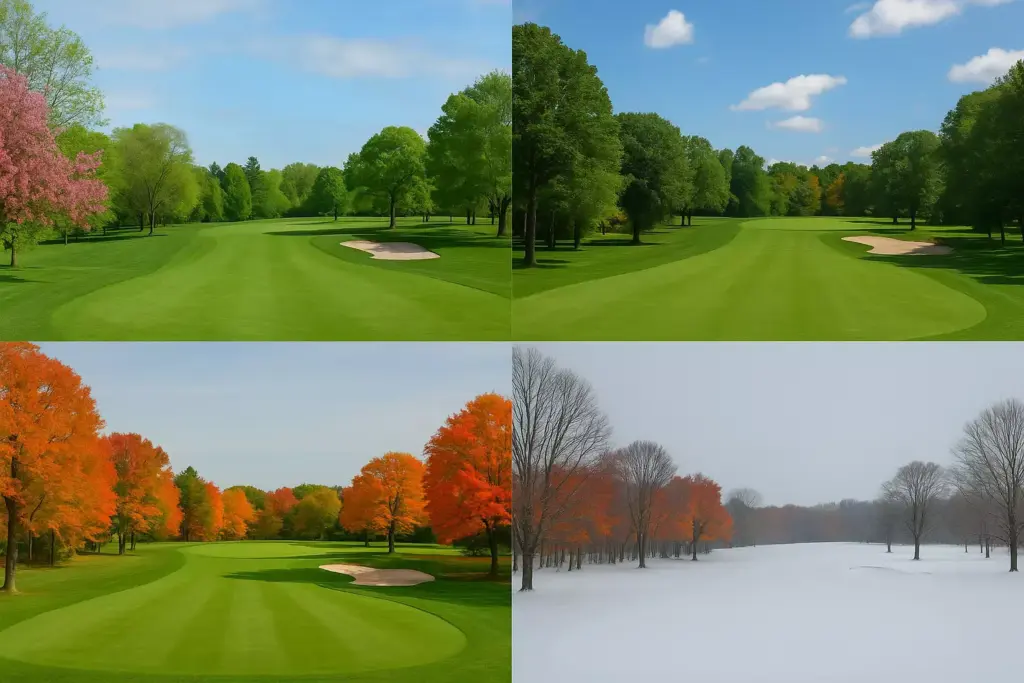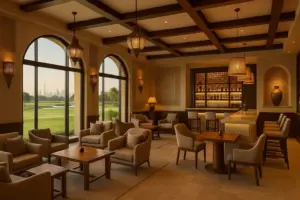Inside the New England Golf Aesthetic: Classic Courses, Coastal Vibes & Heritage Style
Picture this: morning mist rolls across emerald fairways as the Atlantic Ocean crashes against weathered cliffs just beyond the 18th green. A lighthouse stands sentinel in the distance while golfers in crisp polos and cable-knit sweaters navigate courses that have challenged players for over a century. This is the New England golf aesthetic – a timeless blend of coastal beauty, architectural heritage, and sporting tradition that continues to captivate golfers worldwide in 2025.
Key Takeaways

- Classic course design in New England emphasizes natural terrain integration and strategic play over flashy modern features
- Coastal influences create unique playing conditions with ocean winds, salt air, and dramatic seaside holes
- Heritage style encompasses both course architecture and fashion, featuring traditional clubhouses and preppy golf attire
- Seasonal beauty offers distinct experiences from vibrant fall foliage to crisp spring mornings
- Exclusive club culture maintains century-old traditions while slowly adapting to modern inclusivity
The Foundation of New England Golf Heritage
New England’s golf landscape tells a story that began in the late 1800s, when Scottish immigrants brought their beloved game to America’s northeastern shores. The region’s rocky coastlines, rolling hills, and dense forests provided the perfect canvas for golf course architects who understood that the best layouts work with nature, not against it.
Historical Significance 🏛️
The first golf courses in New England weren’t just recreational facilities – they were social institutions that defined community culture. Clubs like The Country Club in Brookline, Massachusetts (founded in 1882) and Newport Country Club in Rhode Island (1894) established the template for what would become the quintessential New England golf experience.
These early courses featured:
- Natural hazards like stone walls and native vegetation
- Modest clubhouses built in Colonial Revival or Shingle Style architecture
- Walking-only policies that emphasized the pure golf experience
- Small, undulating greens that rewarded precision over power
Defining Elements of New England Course Design
Terrain Integration
Unlike modern courses that reshape entire landscapes, classic New England golf courses embrace natural contours. Architects like Donald Ross, who designed numerous courses throughout the region, understood that forcing artificial features onto New England’s varied topography would destroy the very character that made these locations special.
Key design principles include:
- Stone wall hazards that reflect the region’s agricultural history
- Native rough areas featuring fescue grasses and wildflowers
- Elevated tees and greens that showcase surrounding vistas
- Strategic bunkering placed to challenge specific shot angles
Seasonal Adaptability
New England golf courses must function beautifully across four distinct seasons, each offering its own aesthetic rewards and challenges.
Spring (March-May):
- Fresh green fairways emerging from winter dormancy
- Blooming dogwoods and cherry trees
- Soft, receptive playing conditions
Summer (June-August):
- Lush, firm fairways perfect for links-style play
- Ocean breezes providing natural air conditioning
- Long daylight hours extending playing time
Fall (September-November):
- Spectacular foliage creating a natural gallery
- Crisp air and clear skies
- Firm, fast playing conditions
Winter (December-February):
- Snow-covered landscapes showcasing course architecture
- Cross-country skiing and winter walking trails
- Off-season course maintenance and improvements
Coastal Influences on Course Character

The Atlantic Ocean serves as more than just a scenic backdrop for New England golf – it fundamentally shapes how these courses play and feel. Coastal courses must contend with unique environmental factors that create distinctive playing experiences.
Wind Patterns and Strategy
Ocean winds in New England are rarely predictable, shifting direction and intensity throughout the day. This natural variability demands strategic thinking and shot creativity that separates coastal golf from inland alternatives.
Common wind effects:
- Morning offshore breezes that help carry drives
- Afternoon onshore winds that can knock down approach shots
- Crosswinds that require significant aim adjustments
- Gusting conditions that test mental resilience
Salt Air and Maintenance Challenges
The coastal environment presents unique maintenance challenges that influence course conditioning and playability. Salt spray can damage certain grass varieties, while sandy soil affects drainage and root development.
Adaptive maintenance practices:
- Salt-tolerant grass varieties like fine fescue
- Enhanced drainage systems to handle coastal storms
- Wind-resistant tree species for natural windbreaks
- Specialized irrigation to combat salt accumulation
Architectural Heritage and Clubhouse Design
New England golf clubhouses represent some of America’s finest examples of traditional architecture, serving as the social and cultural heart of the golf experience.
Architectural Styles
Shingle Style (1880s-1910s):
- Weathered cedar shingles that age gracefully
- Asymmetrical rooflines and wraparound porches
- Large windows showcasing course views
- Integration with natural surroundings
Colonial Revival (1890s-1930s):
- Symmetrical facades with central entrances
- White clapboard siding and black shutters
- Formal dining rooms and men’s grills
- Traditional New England craftsmanship
Tudor Revival (1910s-1940s):
- Half-timbered construction details
- Steep-pitched roofs and tall chimneys
- Leaded glass windows
- English country house atmosphere
Interior Design Elements
Classic New England clubhouses maintain timeless elegance through carefully curated interior spaces that honor tradition while providing modern comfort.
Essential features:
- Dark wood paneling in main dining areas
- Nautical artwork and maritime memorabilia
- Leather furniture in rich burgundy and forest green
- Stone fireplaces for year-round gathering
- Trophy cases displaying club history
The New England Golf Fashion Aesthetic
The preppy style synonymous with New England golf extends far beyond simple dress codes – it represents a lifestyle philosophy that values quality, tradition, and understated elegance.
Men’s Traditional Golf Attire
Essential pieces:
- Cable-knit sweaters in navy, cream, or forest green
- Polo shirts with subtle stripes or solid colors
- Khaki or navy chinos with a tailored fit
- Leather belt with brass hardware
- Canvas or leather golf shoes in white or brown
Seasonal variations:
- Spring: Light cotton polos with windbreakers
- Summer: Linen blends and seersucker patterns
- Fall: Wool sweaters and corduroy pants
- Winter: Cashmere layers and wool caps
Women’s Classic Golf Style
Timeless elements:
- A-line skirts or tailored shorts in appropriate lengths
- Sleeveless polos or three-quarter sleeve tops
- Cardigans for layering in cooler weather
- Pearl jewelry as subtle accessories
- Classic golf shoes in white or coordinating colors
Accessories and Details
The devil is in the details when it comes to authentic New England golf style. Small touches make significant differences in achieving the proper aesthetic.
Key accessories:
- Leather golf gloves in tan or white
- Canvas golf bags with leather trim
- Wool golf caps or visors
- Tortoiseshell sunglasses
- Nautical-inspired ball markers and divot tools
Iconic New England Golf Destinations

Massachusetts Gems
The Country Club (Brookline)
- Host of multiple U.S. Opens
- Classic parkland design with mature trees
- Historic clubhouse dating to 1882
- Walking-only policy preserves traditional pace
Myopia Hunt Club (South Hamilton)
- Quirky, strategic layout with blind shots
- Authentic links-style conditions
- Spectacular fall foliage views
- Maintains amateur golf traditions
Rhode Island Coastal Classics
Newport Country Club
- Oceanfront holes with dramatic cliff views
- A.W. Tillinghast design masterpiece
- Historic Newport mansion district location
- Challenging wind conditions year-round
Wannamoisett Country Club (Rumford)
- Donald Ross design with subtle strategies
- Hosted multiple major championships
- Classic New England parkland setting
- Emphasis on precision over power
Connecticut Country Clubs
Winged Foot Golf Club (Mamaroneck)
- Two championship courses designed by A.W. Tillinghast
- Host of numerous major championships
- Challenging rough and strategic bunkering
- Traditional caddie program
Maine Coastal Treasures
Kebo Valley Golf Club (Bar Harbor)
- America’s eighth-oldest golf club
- Spectacular Acadia National Park setting
- Historic summer resort atmosphere
- Unique mountain and ocean views
Modern Adaptations of Classic Style
While tradition remains paramount in New England golf, successful clubs have learned to adapt classic aesthetics for contemporary needs without sacrificing their essential character.
Technology Integration
Subtle modernization:
- GPS systems built into traditional golf carts
- Mobile apps for tee time booking and scoring
- Climate-controlled storage for golf equipment
- Updated irrigation systems for course maintenance
Inclusivity Initiatives
Progressive New England clubs are expanding access while maintaining their distinctive culture:
- Junior golf programs introducing young players to traditions
- Women’s golf initiatives encouraging female participation
- Diverse membership recruitment broadening club demographics
- Public access days sharing courses with broader communities
Seasonal Golf Experiences
Spring Awakening (March-May)
Spring golf in New England offers renewal and anticipation as courses emerge from winter dormancy. The season brings unique pleasures and challenges that define the regional experience.
What to expect:
- Soft conditions requiring adjusted club selection
- Blooming landscapes creating natural beauty
- Variable weather demanding layered clothing
- Eager golfers returning after winter breaks
Summer Perfection (June-August)
Summer represents peak season for New England golf, when courses reach their full potential and playing conditions approach perfection.
Optimal conditions:
- Firm, fast fairways rewarding strategic play
- Ocean breezes providing natural cooling
- Long daylight enabling evening rounds
- Tournament season showcasing course quality
Autumn Glory (September-November)
Fall golf in New England is legendary among golfers worldwide, combining ideal playing conditions with spectacular natural beauty.
Autumn advantages:
- Perfect temperatures for comfortable play
- Stunning foliage creating unforgettable backdrops
- Firm conditions maximizing distance and roll
- Clear skies offering exceptional visibility
Winter Beauty (December-February)
While golf season officially ends, New England courses transform into winter wonderlands that showcase architectural beauty and provide alternative recreational opportunities.
Off-season activities:
- Cross-country skiing on cart paths and fairways
- Winter hiking through course landscapes
- Clubhouse dining by roaring fireplaces
- Equipment maintenance and swing instruction
🏌️ New England Golf Course Finder
Preserving Tradition in a Modern World

The challenge facing New England golf in 2025 is balancing preservation with progress. The most successful clubs have found ways to honor their heritage while adapting to contemporary expectations and social responsibilities.
Environmental Stewardship
Modern New England golf courses lead the way in environmental consciousness, implementing sustainable practices that protect the coastal and woodland ecosystems that make these courses special.
Sustainability initiatives:
- Native plant restoration reducing water and chemical needs
- Pollinator gardens supporting local bee populations
- Stormwater management protecting coastal water quality
- Renewable energy powering clubhouse operations
Cultural Evolution
While maintaining their essential character, progressive New England clubs are expanding their definition of tradition to include broader participation and community engagement.
Positive changes:
- Family-friendly programming welcoming all ages
- Beginner instruction lowering barriers to entry
- Community partnerships sharing resources and facilities
- Charitable initiatives supporting local causes
Planning Your New England Golf Experience
Best Times to Visit
Peak Season (June-October):
- Optimal weather and course conditions
- Full amenities and services available
- Higher green fees and accommodation costs
- Advanced reservations essential
Shoulder Season (April-May, November):
- Moderate weather with occasional challenges
- Lower costs and fewer crowds
- Variable course conditions
- Good value for budget-conscious golfers
What to Pack
Essential items:
- Layered clothing for changing conditions
- Rain gear for sudden weather changes
- Comfortable walking shoes for cart-path-only days
- Sun protection including hat and sunscreen
- Camera for capturing scenic moments
Booking Strategies
Advance planning tips:
- Book tee times 2-4 weeks in advance during peak season
- Consider package deals combining golf with accommodations
- Check weather forecasts and have backup plans
- Understand dress codes and club policies
- Plan for walking as many courses prefer or require it
The Future of New England Golf
As New England golf moves forward in 2025, the region’s courses face the ongoing challenge of preserving their unique character while adapting to changing demographics, climate conditions, and social expectations.
Emerging Trends
Technology integration:
- Smart irrigation systems optimizing water usage
- GPS-enabled carts enhancing pace of play
- Mobile apps streamlining club operations
- Virtual reality swing analysis and instruction
Accessibility improvements:
- Adaptive golf programs for players with disabilities
- Junior development initiatives in local schools
- Women’s golf leadership and participation programs
- Diverse membership recruitment and retention
Climate Adaptation
New England courses are proactively addressing climate change impacts through innovative course management and design modifications.
Adaptive strategies:
- Drought-resistant grass varieties reducing water dependency
- Coastal erosion protection preserving seaside holes
- Storm drainage improvements handling increased precipitation
- Season extension technologies maximizing playable days
Conclusion
The New England golf aesthetic represents more than just beautiful courses and traditional style – it embodies a philosophy that values heritage, natural beauty, and sporting integrity. From the windswept coastal links of Rhode Island to the mountain courses of Vermont, this region offers golf experiences that connect players to the game’s deepest traditions while providing challenges that test skill and character.
The enduring appeal of New England golf lies in its authentic integration of natural landscapes, architectural heritage, and cultural traditions. These courses don’t try to overwhelm with artificial features or gimmicky designs. Instead, they offer timeless golf experiences that improve with familiarity and reward thoughtful play.
For golfers seeking to experience this distinctive aesthetic, the key is embracing the complete experience – from the traditional clubhouse atmosphere to the strategic course challenges to the classic style of dress and play. New England golf rewards those who appreciate subtlety over spectacle and tradition over trends.
Next Steps for Your New England Golf Journey
- Research specific courses that match your skill level and interests using the interactive tool above
- Plan seasonal visits to experience different aspects of the New England golf aesthetic
- Invest in appropriate attire that respects club traditions and enhances your experience
- Book accommodations early during peak season, especially in popular resort areas
- Consider golf packages that combine multiple courses with lodging and dining
- Prepare for walking by improving fitness and investing in comfortable golf shoes
- Study course histories to appreciate the architectural and cultural significance
- Embrace the weather as part of the authentic New England golf experience
The New England golf aesthetic continues to evolve while maintaining its essential character, ensuring that future generations will discover the same sense of tradition, natural beauty, and sporting challenge that has defined this region for over a century. Whether you’re a first-time visitor or a lifelong devotee, New England golf offers experiences that enrich both your game and your appreciation for golf’s finest traditions.










